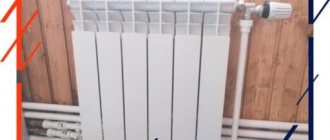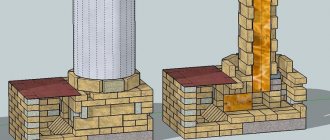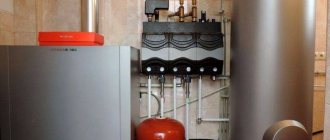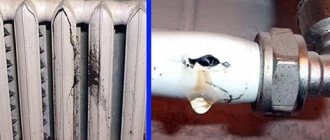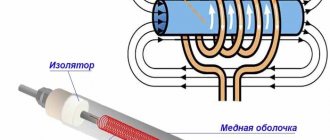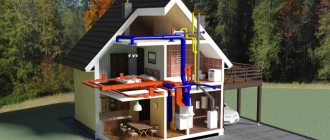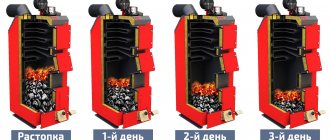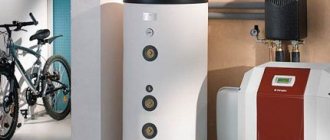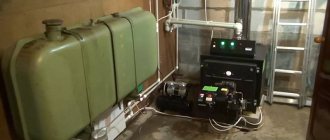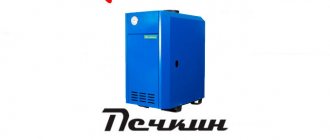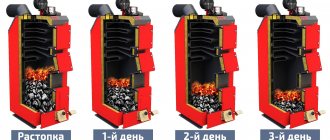In recent years, living in a wooden house has become a fashionable trend. And there are reasons for this. For example, living in it is quite comfortable and at the same time wood is an environmentally friendly building material. If earlier life in a wooden house was associated with many inconveniences, now it is comfort and the use of innovative technologies. The heating system occupies a special place in the house. Some people refuse the idea of hiring qualified specialists who charge quite a lot of money for their heating services. For this reason, they decide to make heating for a wooden house with their own hands. We will look at the basic principles of installing a heating system, as well as possible options for how and from what it can be made.
Features of the heating system in a country house
The traditional heating supply scheme in cottages and small houses is based on water heating with bottom wiring. Natural circulation is used - a slight slope for distribution pipes - or forced: with the connection of pumps.
The heating system in a separate house includes a choice of:
- boiler, electric, gas, wood or combined;
- distribution pipes made of various metals or propylene;
- heating radiators - storage tanks;
- coolant: plain water, purified or antifreeze.
Article on the topic: How to level the foundation of a fence
Autonomous heating in residential premises assumes low pressure in the main pipes. Therefore, when choosing radiators, you will not have to take into account the operating pressure indicator , as is the case with centralized heating. When choosing, focus on the material, its thermal conductivity, power, service life and price.
Single pipe system
The heating system can have a different number of circuits; the single-pipe version is most common. A single-pipe system ensures that hot water rises due to the difference in mass and density with the colder part of the coolant.
Single pipe system
This option is best used for small houses, since with natural circulation the difference in temperature on different floors will be felt. A good way to get rid of this drawback is to use a circulation pump. It is worth calculating all the expenses to understand whether this option will have truly suitable efficiency.
A lot is not a little
A common mistake homeowners make is selecting the size of heat exchangers according to the width of the window opening.
Feel free to leave free space by installing the required number of radiator links according to power calculations.
If you overdo it with the number of sections, you will get dry air, stuffiness or drafts from constantly open windows.
Important ! Do not install one unit of many links in a room: long structures take longer and heat up unevenly. It makes more sense to connect two sets with fewer links.
Saving on radiator sections also negatively affects the microclimate of residential premises. The cold in the rooms will force you to add firewood to the firebox or increase the supply of liquid fuel to the boiler. Operating a “water heater” at peak loads will reduce its service life and lead to excessive consumption of fuel and money. Maintain balance when choosing radiators.
Two-pipe system
If there are two circuits, the hot coolant enters the radiators through a separate line. This ensures faster heating of the rooms, as well as the same temperature in opposite parts of the building. In large houses, uniform heating is important, so this option is optimal there.
Two-pipe system
Sometimes there is a need to expand the house and make new extensions. When using a double-circuit heating system, this will not be a problem; such a system is considered scalable, that is, you can always extend any line. When building houses with a large area of premises, opt for a two-pipe system.
Five installation rules
When installing, take into account the correct location of the batteries and the coolant supply to them.
- If you want to save on energy costs for the boiler , install a two-pipe heating system.
Unlike the traditional “Leningradka” (single-pipe connection), you can control the temperature in each room of a private house.
- Consider the connection location of the links, leaving at least 20 centimeters on the installation side for the process connection.
- Ensure optimal convection of warm air due to the free space at the bottom and top of the autonomous heating radiators.
- Be aware that installing heat exchangers in designer niches and screens leads to a loss of heating power. Sometimes this value exceeds 25% . Compensate for “underheating” by increasing the number of sections.
- Install Mayevsky and ball valves on heating radiators This will not only de-air, but also drain water from the pipes to clean the system.
The best steel heating radiators for the home
Kermi FKO 22 with side connection
Radiators of this German brand are made of high-quality low-carbon steel. They are distinguished by high productivity and a wide range of finished products with different geometric dimensions.
Watch the product video
The lineup
Models are classified by center distance, which can be 146, 346, 446, 546 and 846 mm. The battery can reach a length of 3 meters. All of them are designed for a working pressure of 10 bar and a coolant temperature of up to 110 °C.
Design features
The internal structure of such radiators provides for intense heating of the front panel by the incoming flow of hot coolant. In this case, the rear panel is washed with reverse current. All batteries are sold complete with brackets, plugs, plugs and an air valve. The buyer is given the opportunity to choose a color scheme.
Radiator characteristics:
- height from 300 to 900 mm;
- depth 100 mm;
- width up to 3000 mm;
- weight depends on the geometric dimensions of a particular model.
Kermi FTV 22 with bottom connection
This model of panel radiators is structurally and technically different from FKO, only in the bottom connection. Otherwise, these are the same heating devices.
Watch the product video
Buderus Logatrend VK-Profil 22
Steel radiators of this brand are made by roller welding, which increases the reliability of the finished product. They have a neat appearance and high thermal properties. The devices are designed for 50 years of trouble-free service.
Watch the product video
The lineup
The manufacturer produces radiators with heights of 300, 400, 500, 600 and 900 mm. Their length can be from 400 to 3000 mm. They are adapted for bottom connection. White powder coating provides reliable protection of the radiator from external influences. Working pressure 8.7 bar. The temperature of the circulating fluid is up to 120 oC.
Design features
The radiator consists of:
- two heating panels;
- internal fins;
- top grill;
- side walls.
The delivery set of each model includes a thermostat, an air vent, two pipes with 3/4” external thread for connecting pipelines.
Buderus Logatrend K-Profil 22
Steel radiators of this series, unlike the VK series, are designed for side connection. Otherwise, their properties and characteristics are identical.
Watch the product video
ARBONIA 3037
Steel tubular radiators of this brand consist of several standard sections welded together. They effectively heat a room through radiation and convective heat transfer. The products are simple and reliable to use. Service life reaches 25 years.
The lineup
ARBONIA 3037 radiators have an even number of sections ranging from 6 to 30. The center distance is 300 mm. Depending on the length of the radiator, which can reach 1374 mm, the thermal power of the models ranges from 354 to 1770 W. The device is designed for long-term operation at a pressure of 10 bar and temperatures up to 120 °C. The buyer can order a product in the color he likes.
Design features
The main design advantage of these radiators is that each section consists of three pipes, which provides higher heat transfer.
Heating radiators of this brand differ:
- standard shape, reminiscent of cast iron radiators;
- reliable welded construction;
- lateral connection;
- ready for installation with the ability to connect a Mayevsky tap and ½ and ¾” pipelines.
What characteristics should you look for when choosing?
The purpose of heating devices is to transfer heat and distribute it evenly throughout the living rooms, creating a comfortable temperature in the cold season - at least 20–22 °C.
Article on the topic: Where trees are cut down for a Russian bath
It is difficult for a beginner to navigate the variety of radiators on the market for heating private homes. Sometimes an ignorant person pays attention only to appearance and cost . This is a misconception that can cost you dearly.
Experts recommend being guided primarily by the technical characteristics of the elements of the autonomous heat supply system. You can familiarize yourself with them in the product passport or seek the help of a sales consultant.
Attention! To determine the power of heating devices, take into account the heat loss of living rooms. They must correspond to the heat loss of the building per unit of time (one hour) , depending on the wall material, outside temperature, and climate zone.
Electric heating system
It is believed that electric heating of a private home is the most environmentally friendly method. But electric heating is a very expensive option. The use of such a system will subsequently be expensive, regardless of what you install for yourself - a heated floor system or an electric boiler, or limit yourself to convectors.
When using electricity, you will need to carefully insulate the house, otherwise the street will be heated. But electric heating of a private home can be made fully automated, and its operation will bring a lot of pleasure, in addition to ease of use.
The most popular today are infrared heaters. They consume less electricity and are extremely simple to operate. They do not heat the air in the room, as with a traditional heating system, but all solid objects falling within the radiation radius.
Heating batteries in a wooden house
Wooden houses are a type of residential structure for the construction of which environmentally friendly raw materials are used.
They are built from logs or timber and have a beneficial effect on a person and his well-being. The performance properties of wood contribute to the creation of a unique indoor microclimate. To maintain the desired temperature, it is necessary to correctly select the type of heating system and its structural elements.
What radiators should be like in a wooden house is determined by the characteristics of the building material and the characteristics of the heating network.
TM Ogint offers a wide range of heating batteries, components for installation and the necessary pipeline fittings. All elements for assembling the heating network are designed for operation in the Russian Federation and comply with the requirements of European standards.
Other types of heating
Sometimes water heating is combined with electric heating, which is a good heating option in the absence of gas.
Electric heating is often associated with heating a room with convectors. This option is good for small rooms that are rarely used - bathhouses or summer cottages. Convectors for large rooms are quite expensive.
Warm floors are also popular, but installing them in a wooden house is very problematic - you will have to very carefully draw up a house project in order to do everything right. Moreover, it is very difficult to do this on your own.
Video:
The advantages of a heated floor system include silent operation and high accuracy of transmitted temperature.
The installation scheme for a heated floor is quite simple - the pipes are laid on heat-insulating material.
The distance from the beginning of the pipe to the wall is about 10 cm, the second pipe is laid 20 cm from the first.
Then the pipes are laid in the opposite direction, with a distance of 20 cm between them
Pipes for heated floors can be positioned as you like - in a spiral or around the perimeter, it doesn’t matter
Stove heating in a wooden house is still popular. Only specialists can fold it correctly.
However, people choose just such a heater for their dacha, because many know how to handle it, its features and how to heat a room with its help. Many people are not even bothered by the prospect of frequently adding logs to the fire and regularly checking the flame.
For a wooden country house, this type is better than heating with electricity, convectors or gas. The stove is even superior to water heating in some ways - there is no risk of damaging the wood.
Video:
Features of choosing radiators
When planning to install batteries in a wooden house, you need to take into account the seasonal susceptibility of natural material to shrinkage. Changes in the geometry of the walls and possible deformations in spring or autumn can lead to damage to the heating network pipes. To avoid this and prevent undesirable consequences, heating risers in a wooden house are secured using sliding joints. Thanks to this fixation, the pipes move freely over a short distance, maintaining the tightness of the network.
Typically, wooden houses are private low-rise buildings with an autonomous heating system. It is advisable to use a gas or electric boiler as a power source for the network, since solid and liquid fuel equipment requires additional safety measures.
When choosing batteries for heating a wooden house, you need to consider the following factors:
- type and characteristics of the coolant;
- pressure in communications and maximum temperature;
- heat transfer coefficient of radiators;
- cost of heating devices.
Article on the topic: Smokehouse in the garage as a business
The pressure in an autonomous heating network depends on the circulation of the working medium through the pipes. Circulation can be natural or forced. The maximum pressure value usually does not exceed 4-5 bar. In addition, in such systems the occurrence of water hammer is eliminated, and the parameters and composition of the coolant can be adjusted. Therefore, when choosing radiators for autonomous systems, there are no strict restrictions. Which batteries are best to purchase for a wooden house depends on the intensity of use of the heating network and the preferences of property owners.
Features of heating and its types
Heating installation
One important factor should be taken into account, which directly affects the choice of heating type. The tree, after a short time, loses its natural moisture and, accordingly, dries out. This will entail some consequences, namely settlement of the house. For this reason, the type of heating should be chosen individually in each case. It is first necessary to carry out careful calculations, as well as draw up a project that can facilitate installation work. One mistake in incorrect calculations can lead to the most unexpected and unpleasant consequences, for example, burst pipes or complete defrosting of the system. If the electrical heating calculations are carried out incorrectly, then the matter may end in a short circuit. And if you chose an air system, then it will be impossible to fix anything. The choice of heating type will be directly influenced by the available energy source. Today the following can act as an energy carrier:
- Liquid fuel.
- Electricity.
- Solid fuel.
- Gas.
Based on this, you can select the “heart” of the entire heating system of a wooden house - the boiler.
Types and characteristics of radiators
TM Ogint sells cast iron, aluminum and bimetallic batteries. Each type of heating device has its own advantages and disadvantages.
Cast iron
Radiators made of cast iron are reliable and durable, are resistant to corrosion and can withstand up to 12 bar. They remain functional for 50 years and are not sensitive to the composition of the coolant, but have a low level of heat transfer and significant weight. Cast iron batteries are characterized by high thermal inertia, so when installing them in a private home, thermostats should be used. They allow you to maintain the desired temperature in the premises and prevent overheating of the wood.
Aluminum
Aluminum radiators are distinguished by high thermal output and attractive design. However, in an interior where natural materials predominate and the furnishings are chosen in eco, country or Provence style, such batteries look alien. To avoid disharmony, they are covered with special screens. Aluminum radiators are susceptible to corrosion, so when installing them it is necessary to monitor the quality of the coolant and maintain the acidity of the working environment within pH 7-8.
Bimetallic
Bimetallic batteries can withstand up to 20 bar and are resistant to water hammer, so they are most often in demand when installing centralized heating networks in apartment buildings. They can also be purchased for an autonomous system in a large private house, where the level of heat transfer from radiators will allow you to save on heating the premises. The high cost of bimetallic batteries is compensated by their long service life, which is up to 20 years, and the lack of tendency to corrosion.
Pipe fittings: an integral attribute of the heating network
For the efficient functioning of the heating network and radiators, the installation of pipeline fittings should be provided. TM Ogint offers the following devices that need to be installed on batteries:
- Mayevsky cranes. They will help avoid air accumulation in the system and ensure uniform heating of all heating devices;
- thermostats. Used to control the temperature in rooms;
- shut-off valves. Allows you to carry out repair and maintenance work on individual radiators, regardless of the type of circuit and wiring of the heating network.
Article on the topic: Which heated floor is better for a wooden house
Using TM Ogint products, you can assemble a reliable, cost-effective and durable heating system for a private home made of natural wood.
Gas holders are a good alternative
How to heat a wooden house if it is not connected to a central gas supply system? There is a worthy answer to this question: you need to use a metal tank designed for storing liquefied propane-butane. Such containers are made of high-strength steel coated with an insulating agent. Shut-off and control valves are installed on the top cover of the tanks, consisting of a fill level indicator and valves.
Heating a wooden house using a gas holder is an excellent solution, because such a system is completely autonomous. Other advantages should also be mentioned:
- safety – metal tanks are certified for use in our country;
- good performance - gas tanks are installed in a horizontal position, which increases the area of fuel evaporation;
- aesthetics - the container is located underground. The tank lid can be decorated with artificial stone;
- a gas holder for heating a house is best suited because it does not require frequent refueling;
- environmental friendliness - when using steel containers with fuel, the environment is not heavily polluted.
Gas holder heating - reliable, affordable and safe
The disadvantage of this method is the high cost of equipment and installer services. But if people have no other choice, this method is quite acceptable.
Regardless of the chosen option, to ensure that the system functions stably and there are no unpleasant surprises, it is better to entrust the heating installation in a wooden house to professionals. Specialists use time-tested schemes, select high-quality materials and perform their work competently.
Radiator heating in a private house
When choosing a heating system for a summer house or home, you need to take into account installation costs, ease of use and efficiency. Water heating is equally suitable for brick, block, frame and wooden houses. This option is cheaper to use compared to installing electrical heating equipment and is more efficient than a conventional stove, the fuel for which is coal or wood.
Radiator heating in the house
A radiator heating system for a country house or cottage has an advantage over water underfloor heating, since installing pipelines and radiators is easier and faster than laying a circuit and installing a screed.
Autonomous heating differs from central heating:
- low working pressure;
- no risk of water hammer;
- the ability to regulate the temperature of the coolant, set the permissible maximum;
- the ability to adjust the acid balance of the coolant;
- efficiency.
At the design stage of an autonomous system, it is necessary to decide which heating radiators and pipes to use for installation. Its functionality, efficiency and durability depend on this.
Installation of a chimney or boiler room
The chimney can become very hot during operation of the heat generator, which carries a significant risk of wood fire. Therefore, it is necessary to use certified chimneys made of fire-resistant materials with insulation. The best option is considered to be a free-standing brick chimney with its own foundation, which rises above the house to a height of up to 2 meters.
This design provides excellent traction, effectively removes combustion products and reliably protects a wooden house from temperature effects. Installation of a gas boiler must be carried out on a fire-resistant floor or wall base. If a solid fuel heat generator is used as a heat source, it is necessary to take care of a full-fledged boiler room in which all horizontal and vertical surfaces are not hot.
The article was written for the site.
Tags:Heating boiler, Heating radiator
Types of heating batteries
To choose radiators with the best performance for heating a private home, you need to understand the advantages and disadvantages of heating batteries that the market offers. Each type of heating device should be considered based on the properties of the material and design features.
Types of heating radiators
Radiators vary
:
- by material of manufacture (steel, aluminum, cast iron, bimetallic);
- by design (sectional and solid):
- according to the principle of heat transfer (radiating thermal energy, convection and combined).
Steel
Among heating radiators for private homes, steel models are in steady demand. Their list of advantages includes:
Article on the topic: Is it necessary to corrugate wires under a suspended ceiling in a wooden house?
- relatively light weight, which simplifies installation;
- fast heating and cooling – allows you to flexibly regulate the room temperature when using a thermostat, saving fuel;
- quite long service life;
- a wide selection of models with different functionality and appearance.
Kermi steel radiator in the interior
The disadvantages of steel heating devices include:
- tendency to corrosion - such batteries are designed for installation in a closed heating system, since the free penetration of air into the coolant accelerates the process of destruction of the metal;
- tendency to become overgrown due to the rough inner surface - regular flushing of the system is required;
- restrictions on the characteristics of the coolant - the addition of alkaline reagents should be avoided.
To understand which steel heating device to choose, we will consider each type in detail. Manufacturers offer sectional, tubular, panel and convector steel heating devices.
Sectional
The battery consists of individual units, the number of which can be changed. This is a serious advantage of heating devices of this type. If the thermal calculation is performed incorrectly and the radiator power is not enough, additional sections are added. If the house has been insulated and the need for powerful radiators has disappeared, it is enough to remove the extra sections to reduce energy consumption. The advantages of sectional models also include a stylish design that will fit into any interior. The disadvantage is the large number of joints, which increases the risk of battery depressurization.
Sectional heating radiator in the interior
Tubular
Panel
Convector
Cast iron
When considering different types of radiators, one cannot ignore the classic option - cast iron batteries. To this day, working copies installed before the revolution have been preserved in old houses. In Soviet-built houses, mass-produced cast iron radiators are used.
The advantages include durability and corrosion resistance, high heat transfer, and the ability to install additional sections. The list of disadvantages includes a tendency to overgrow - over time, the heat transfer of such batteries decreases, as the free space inside the case narrows. Unlike modern heating appliances, cast iron radiators require regular painting. Disadvantages also include heavy weight, which makes transportation and installation difficult.
Before choosing a cast iron battery for a private home, you need to pay attention to its high thermal inertia. It heats up and cools down slowly, which makes it impossible to quickly regulate the microclimate in the room.
Today, in private homes, cast iron radiators are installed if they want to emphasize their individual image. Manufacturers offer original floor models, decorated with artistic castings, which will perfectly complement the interior in a classic style.
Article on the topic: How is a sauna barrel insulated?
Variety of cast iron decorative radiators
Aluminum
When deciding which heating devices are best for a private home, pay attention to aluminum models. Such radiators are in growing demand among private developers due to their light weight and ease of installation, attractive appearance, and the ability to add and remove sections. The cost of the product depends on the manufacturer. Domestic products are as affordable as possible; this is a budget country option. In a country house, it is better to install imported products; they are more reliable, but also more expensive.
Aluminum radiators:
- may leak due to the presence of threaded connections;
- aluminum is picky about the acidity of the coolant - using a liquid with unsuitable parameters damages heating devices;
- due to increased heat transfer, they can poorly warm the lower part of the room - the heated air quickly goes up and the floor remains cold.
But despite this, it is wise to choose an aluminum radiator for a private home - the metal quickly heats up and cools down, making it possible to quickly change the heating level of the room in accordance with weather conditions and microclimate requirements. In this regard, aluminum batteries are the most practical.
Bimetallic
Such heating devices combine the advantages of steel and aluminum models. The inner surface of a durable iron alloy is undemanding to the characteristics of the coolant and ensures the structural strength of the battery. The external aluminum casing is characterized by good heat transfer, due to which the radiator effectively warms the room.
The bimetallic radiator is designed for high operating and pressure testing, which makes it the optimal choice for installation in an apartment connected to a central heating network.
Considering the high cost of high-quality bimetallic models, in private homes it is better to use a budget option for heating, designed to work in an autonomous system.
What are the benefits of electric heating?
Bringing a highway to a site is expensive, so many homeowners are looking for other options. The use of liquid fuel boilers is not suitable for everyone, because a special container is needed to store diesel fuel. But heating a wooden house with electricity is a worthy solution to the problem. What is the rationale for this? There are many arguments:
boilers operating on electrical energy have a number of significant advantages. This includes operational safety, compactness, efficiency, noiselessness, and environmental friendliness. Electric boilers fit perfectly into the interior as they have an elegant appearance. In addition, the equipment is equipped with automation. With the help of “smart” devices, the temperature in the rooms is regulated, energy saving is ensured and control is carried out from a distance;
Electric boiler "Dakon Daline PTE" connects to any heating systems
water heating - double-circuit boilers are used for this purpose; large selection of radiators - heating batteries for a wooden house are presented in a wide range: aluminum, steel, bimetallic
Leading manufacturers pay close attention to product quality and develop interesting ideas. Aluminum batteries last a long time and have fast heat dissipation
Steel radiators are affordable, while bimetallic ones can withstand high pressure.
When considering options for heating a wooden house with electricity, you need to say a few words about the use of heaters. Basically, electrical appliances are used as additional sources. They are classified according to the nature of heat transfer. Electric heating in a wooden house is provided using different heaters:
- Oil radiators - they do not irritate the respiratory system.
- Convectors are portable devices whose operating principle is based on the passage of air from the bottom panel to the top through a heating element.
- IR devices are heaters that have a positive effect on the body.
Convectors "Zilon" take up minimal space and provide instant heating
Principles for calculating battery power
To choose heating radiators for a country or private house, you need to perform calculations based on the fact that to heat one square meter. m of living space requires approximately 95–125 kW. To warm up a room with average parameters (one window, one door, ceiling height up to 3 meters), it is necessary to heat the coolant to 70 °C.
Article on the topic: Where is the cranberry garage sold?
If actual parameters differ from those indicated, adjustments must be made. For example, with a ceiling height of more than 3 meters, it is necessary to increase the calculated power of the batteries as many times as the actual height exceeds the conditional one. For low ceilings, recalculation is carried out in the opposite direction.
A decrease in coolant temperature for every 10 °C relative to the specified average level forces a corresponding increase in the design power of heating devices by 15–20%. If the room is corner and has two windows, the average calculated power of the batteries is increased by 1.5 times.
The heat transfer of radiators largely depends on their connection diagram. The average calculation is based on the fact that the heated coolant is supplied to the upper side inlet, and the return is connected to the lower inlet diagonally. Other connection options are less efficient and reduce the heat dissipation of batteries by 5–10%.
Note! The number of sections for radiator models of this type should not exceed 10 pieces - further expansion will not help increase power, since the coolant will not be able to fully warm up such a battery.
Comparison of thermal power of different types of batteries
Calculating radiator parameters
Particular care should be taken when choosing panel and tubular batteries. Manufacturers include in their product line models of the same power, but with different geometric parameters. When choosing, take into account the features of the installation location - the height from the floor to the window sill, the length of the wall in an elongated room, etc.
Homeowners choosing heating devices and wanting to purchase the best options at a reasonable price opt for steel or aluminum models. The cost of the most reliable, imported bimetallic radiator is prohibitively high, and cast iron batteries have many serious disadvantages. According to statistics, those who are thinking about which radiators to choose for a private home or country house choose aluminum sectional or steel panel models based on the ratio of price and practicality.
Video with tips for choosing heating radiators:
Installation of a "warm floor" system
We use heating mats
Stage 1: it is most convenient to use electric heating mats, although they will cost 20-25% more than cable. A groove is made in the wall and floor where the cable in a corrugated tube will go, connecting the heating mats to the energy source, and the temperature sensor. Then all debris and dust are removed from the floor surface. Heating mats can be placed directly on old tiles. The mat mesh is easy to cut, and if the mat is rotated, a cut can be made, but the heating cable must not be touched.
Stage 2: the mat is attached to the floor using a heat gun or tape. Sometimes an adhesive layer on the mesh is already applied to the surface of the mat, and the mat itself sticks well.
Stage 3: a layer of tile adhesive is applied on top of the mat. You need to let it dry completely for 5-7 days.
Stage 4: all connections must be made and the thermostat connected. The functionality and serviceability of the heating system is checked.
Stage 5: You can lay the floor covering on the completely dried adhesive base.
We use a cable
main source of heating
Stage 1: the floor is cleared of old tiles or other material before laying the heat insulator. All debris is swept out and dust is removed.
Stage 2: sheets of heat insulation are laid out on the cleaned surface. The joints between the sheets are taped.
Stage 3: a reinforcing mesh is laid on top of the thermal insulator and an intermediate screed no thicker than 3 cm is poured. Wait 3-5 days until it dries completely.
Stage 4: after the screed has completely dried, mounting tape is applied to it.
Stage 5: a detailed cable laying diagram is drawn up. You need to start laying from the bridge connecting the wiring to the thermostat. It is necessary to take into account the cable manufacturer's recommendations regarding the minimum bending radius of the cable and the minimum distance between the cable threads. Do not run the cable under areas where plumbing fixtures and furniture will subsequently be installed.
Stage 6: the thermostat is installed inside the corrugated tube. All components of the electrical system are connected.
Stage 7: after checking the operation of the heating system, a second screed 3-10 cm high is laid. You must wait a month until it dries completely.
Stage 8: Now you can lay any flooring.
What metal batteries should be used in a country house?
There are a large number of battery designs on the heating equipment market. According to their design, all heaters can be divided into the following types:
- Tubular.
- Copper.
There is also a classification based on the metal used in the production of radiators. It is customary to distinguish the following equipment:
Each metal has its own performance characteristics, heat transfer coefficient and other features. To determine the best radiators, you should consider in detail the disadvantages and advantages of each.
Cast iron radiators are time-tested classics
Sectional batteries - the main advantage of cast iron is the high quality and strength of the metal. Thick-walled cast iron makes the batteries almost eternal. The advantages include:
Reliability and durability.
Possibility to add sections to increase the total power of the device.
The disadvantages include low heat transfer, unsightly appearance and large dimensions of the device, stealing free space.
In the event of an emergency shutdown of the boiler, the heated cast iron battery will cool down for a long time and will not allow the coolant temperature to drop quickly.
Bimetallic, aluminum and copper batteries - high heat transfer and reliability
If we talk about heat transfer, then you cannot find better copper and bimetallic radiators. The batteries can withstand high pressure and practically do not react to the quality of the coolant.
It is not advisable to install bimetallic models for a private home. Radiators of this type were originally developed for connection to central heating.
As an alternative, you can use aluminum batteries, which are less expensive than their bimetallic counterparts. At the same time, the heat transfer of radiators is in no way inferior to devices made of two metals.
Steel radiators are a cheap and popular option
For autonomous heating of a private home, steel heating devices are most often chosen. This is due to many factors: low cost, beautiful appearance, good heat transfer performance.
Bottom and top connections are provided, the possibility of operation in one and two-pipe heating systems.
The disadvantage of steel batteries is the susceptibility of the structure to corrosion. Another disadvantage is the inability to add power if there is an error in the calculations, as is the case with cast iron or bimetallic contractions. It is prohibited to place batteries in rooms with high humidity.
Article on the topic: What is a hygrometer for a bath
The best aluminum radiators for the home
Global ISEO
This brand is produced by an Italian company with almost half a century of history. Compact and elegant radiator models fit perfectly into window sill niches and look good in open space. In their manufacture, high-quality aluminum is used, which guarantees their durability and excellent thermal properties. This product is one of the most popular on the Russian market.
Watch the product video
The lineup
The model range of this series includes radiators with center distances of 350, 500, 600, 700 and 800 mm. They have a prefabricated structure consisting of several sections.
Performance characteristics:
- coolant – water or steam with a temperature of up to 110 oC;
- pH of the environment from 6.5 to 8.5;
- working pressure up to 16 atmospheres.
The number of elements in the radiator is selected according to the required power. With a temperature difference of 50 °C at the outlet and at the inlet, it is 87 W for the shortest section, and 164 W for the longest. The standard equipment includes a glossy white finish.
If desired, the buyer can order products in the following colors:
- sandy white;
- Ivory;
- beige, quartz, dark gray, gray-silver or red-brown matte metallic.
Design features
Global ISEO radiators have a large heat exchange area, a wall mount hidden from prying eyes, an easy-to-clean outer surface and a presentable appearance. The liner can be made from any side. Connection thread 1”. It is recommended to install each battery complete with an air valve and shut-off valves.
Section characteristics:
- height from 432 to 882 mm;
- depth and width 80 mm;
- weight from 1.04 to 1.87 kg;
- the optimal location is 3 cm from the wall, 10 cm from the floor and window sill.
Global Vox
Another model of aluminum radiators from the same Italian company. These radiators are easy to install, highly efficient and aesthetically pleasing. They are mounted complete with steel or plastic pipelines. During their operation, the pH of the coolant should not shift towards an alkaline environment.
Watch the product video
The lineup
Finished products are a prefabricated structure of sections with center distances from 350 to 800 mm. All of them undergo factory tests for density and strength, which guarantees their high reliability.
Working conditions:
- coolant – water or steam with a temperature of up to 110 oC;
- medium acidity index from 6.5 to 8.5;
- system pressure up to 16 ati.
The number of elements in the radiator is selected taking into account thermal characteristics. The power of one section at a temperature gradient of 50 °C, depending on its height, ranges from 95 to 181 W. The manufacturer produces equipment in various colors, which simplifies the selection of radiators for any interior.
Design features
Global Vox radiators are certified in accordance with international and Russian standards. The high quality of carefully selected and tested aluminum alloy, combined with two-stage painting technology, gives the products of this brand particularly reliable operation. 1" pipe connections are used for connections.
Section characteristics:
- height from 440 to 890 mm;
- depth 95 mm;
- width 80 mm;
- weight from 1.12 to 2.21 kg.
Royal Thermo Revolution
Heating batteries of this brand are highly reliable and affordable. They are made of high-quality aluminum alloy and have a pleasant appearance. They are characterized by increased power and resistance to hydraulic shocks. The manufacturer provides a 10-year warranty.
Watch the product video
The lineup
Royal Thermo Revolution radiators are available with center distances of 350 and 500 mm. You can purchase finished products consisting of 4, 6, 8, 10 and 12 sections. All of them are designed for a working pressure of 20 atm. The power of each section with a height of 350 mm at a temperature difference of 70 degrees is 128 W, and for 500 mm - 170 W. Radiators are supplied factory painted in universal white.
Design features
Heating radiators of this brand have a number of characteristic differences. They have a wave-shaped fin shape, which improves convective heat transfer by 3%. The circular cross-section of the collectors allows for the best possible distribution of internal loads. Patented plugs with a nanopolymer membrane increase the strength of connections and prevent corrosion. Environmentally friendly paint, applied using a 7-step technology, provides long-lasting protection from external influences and guarantees the safe operation of devices in children's rooms.
Section characteristics:
- height 420 or 570 mm;
- depth 80 mm;
- width 80 mm;
- weight 1.01 or 1.3 kg.
Royal Thermo Indigo
Powerful aluminum radiators of this domestic brand are designed for use in rooms with increased heat requirements. They are suitable for spacious rooms with large windows. Their modern design is suitable for any interior, and the 10-year manufacturer’s warranty leaves no doubt about the high quality of the build and the materials used.
Watch the product video
The lineup
The Royal Thermo Indigo radiator is produced in one modification, having a center distance of 500 mm. The buyer can order a standard battery of 4, 6, 8, 10 or 12 sections. The products are used in individual or centralized heating systems with pressures up to 20 bar. The color of the model arriving from the factory is white.
Design features
The radiator of this brand has an additional wing that cuts off the flow of cold air from the window. It has an increased heat exchange area. The efficiency of this model is 5% higher than the thermal characteristics of analogues. The materials used are characterized by increased strength and resistance to water hammer. High-quality painting helps extend the service life of products.
Section characteristics:
- height 585 mm;
- depth 100 mm;
- width 80 mm;
- weight 1.35 kg.
Royal Thermo DreamLiner
Aluminum radiators of this model combine increased efficiency, exceptional reliability and modern design. They create a stable convective flow that prevents cold air from entering from the window and provides the most comfortable conditions for staying in the room.
Watch the product video
The lineup
Royal Thermo DreamLiner is available with a center distance of 500 mm. Radiators are painted white and have from 2 to 14 sections. The power of each of them is 197 W. The batteries are designed for a working pressure of 20 atm.
Design features
The radiator of this brand is made by casting under high pressure. The aluminum alloy used for this with the addition of titanium, magnesium and manganese provides high strength and ductility of the product. All internal surfaces of the sections are treated with a composition that is resistant to corrosion and abrasive wear. The design has a perfect aerodynamic shape and increased contact area with the air.
Section characteristics:
- height 585 mm;
- depth 87 mm;
- width 80 mm;
- weight 1.31 kg.
Rifar Alum
Aluminum radiators Rifar Alum are ideal for installing individual heating systems. With a laconic design, they are distinguished by high power and durability. The following can be used as a coolant:
- water;
- water vapor;
- antifreeze.
The lineup
Batteries produced by the manufacturer with center distances of 200, 350 and 500 mm allow you to select the appropriate model for any installation conditions. The working pressure of such radiators is 20 atmospheres. Products with a number of sections from 4 to 14 go on sale. Depending on the height, each section creates a heat flow of 99, 137 or 186 W.
Design features
The design features of these radiators are the unique shape of the vertical channels and the use of EPDM membranes during assembly. The special configuration of the gaskets creates locking connections that are highly reliable. The service life of the finished device exceeds 25 years, which is confirmed by the manufacturer’s 10-year warranty.
Section characteristics:
- height 265, 415 or 565 mm;
- depth 90 mm;
- width 81 mm;
- weight 0.72, 1.00 or 1.42 kg.
How to correctly calculate the number of sections
Calculating the power of heating radiators in a country house depends on several factors. The calculations look like this:
- The thermal power of the radiator section is determined. For cast iron appliances, the performance is 100-150 W, aluminum and bimetallic – 150-180 W. You can check the power of the battery section in the technical documentation.
The heated area is calculated. Calculations are performed as follows: the length of the room is multiplied by the width. The result obtained will be the total heated area.
Calculation formula - there is a simple rule that allows you to perform the calculations yourself. For every 1 m² of heated area, a thermal power of 100 W is required.
Calculate the heating radiators of a private house. Calculation of total battery power. Calculations are performed not based on the total area of the house, but individually, for each room, based on the location of the batteries in the house. For example, you can calculate how much thermal energy is needed to warm a room with an area of 20 m², taking into account that for 1 m², 100 W of energy is required, heating a room with a ceiling height of no higher than 2.7 m is performed by a 2 kW heater. Approximately 10-15% should be added to the result obtained for possible heat loss. It turns out 2.3 kW. If there is excess heat, you can reduce heat transfer by adjusting the radiators. A thermostat, in the form of a faucet or thermostat, is installed on bimetallic and aluminum batteries.
General recommendations for installation
When you need to select batteries, you must first determine the type of heating system: autonomous, centralized. The load on the devices will depend on this. Additionally, the area of the heated object is determined. The number of sections will depend on this parameter: the larger the room, the larger the radiators should be.
At the same time, the intensity of heat loss is taken into account. To avoid rapid cooling of the air in the room, you need to position the batteries correctly. They are installed near each opening in the wall. Then warm air is removed from the room less intensively.
Radiator placement rules
When designing a heating system, it is not enough to determine the power of the devices. It is important to arrange them according to the rules. The main installation errors that lead to a decrease in the efficiency of the system: uneven heating of the air in the rooms, significant heat loss. Recommendations for installing radiators:
- the most suitable place in the room is under the windows: it is better to place the batteries in the center of the opening; a width corresponding to 70% of the window width is considered sufficient;
- the minimum distance from the wall to the radiator is 5 cm;
- leave 10 cm between the window sill and the battery;
- a gap of 10-15 cm is provided between the floor and the heating device, the most suitable value is 12 cm;
- when the battery is installed not near the opening, but on a blank wall, it is recommended to leave a gap of 20 mm between the vertical surface and the radiator.
Calculation of the number of sections
If it is not possible to install the most efficient heating devices, you can focus on the accuracy of the calculations. In this case, a sufficient number of sections is determined. 1 m³ will require 41 W of thermal power. When the windows are sealed, the value of this parameter is reduced to 34 W. To determine the total volume of the room, you need to multiply its height by the floor area. To calculate the thermal power of a room, you need to multiply its volume by a unit of thermal power (34-41 W).
Which brand of radiators is better to choose for a house outside the city?
There are Italian, German, Turkish and domestic heating radiators on the market. You can also buy several models made in China.
When determining which brand of radiator is better, you should take into account consumer reviews and the quality of the product itself. Below is the popularity ranking. The list is compiled in descending order of popularity.
All these brands are popular and have many positive reviews. Thanks to the thoughtfulness of the design, connecting heating radiators in a private home is quick and practically effortless. The product has a service life of at least 15 years and is provided with a manufacturer's warranty.
Article on the topic: How to calculate square meters of a garage
You can choose other models based on the means, building features and technical aspects.
Is gas heating suitable for a log house?
Autonomous gas fuel heaters are used very rarely in local heating systems for houses made of timber. This is due to the presence of open fire in such devices. There is another significant drawback of gas heaters. During fuel combustion, they burn oxygen in heated rooms.
At the same time, gas fuel is the most common energy carrier for autonomous heating systems in private homes. The main condition for such systems is the ability to connect to the central gas main. Modern heating boilers that run on gas are characterized by their efficiency, automated control system and high power. Such a unit can effectively heat a house made of timber with an area of several hundred square meters. There are floor-mounted and wall-mounted models of gas boilers. The latest devices can be used without installing separate chimneys. The main disadvantage of autonomous heating using such boilers is the high cost of laying a gas pipeline to the house. In the absence of such an opportunity, some developers use gas holders or liquefied gas cylinders. Such decisions are not always economically justified.
Despite all its shortcomings, gas heating is considered the most convenient and cost-effective option for a house made of timber. Very often, floor heating systems are used together with such boilers. In private houses with a small area, gas convectors can be installed. To install heating systems using gas fuel, you will need equipment such as a gas boiler (the best option is automatic wall-mounted models with a pump), polypropylene gas pipes and special shut-off valves.
It is important to design and professionally install a chimney for a gas boiler. A disk with a small hole is built into its base. To calculate and arrange the chimney structure, you will need an experienced stove maker. It is not allowed to place a gas boiler in basements. Such equipment is located in the hallway or in the kitchen. Installing a convector allows you to achieve more economical operation of the heating system, since it becomes possible to regulate the temperature in individual rooms of a log house.
Rules for the location of batteries in the house
To make the most efficient connection, you must strictly follow the rules for installing heating radiators. The most effective recommendations can be identified:
- Placing radiators in a private house. Heating devices are located in such a way as to create a heat flow that reduces heat loss. Recommended installation locations for batteries are under windows, on the load-bearing wall of the building.
Methods of connecting heating radiators in a country house affect the heating efficiency. The main disadvantage of a system with forced coolant circulation is that it cannot work during a power outage. The problem is solved by connecting a generator or installing a bypass. Systems with natural circulation are ineffective and require strict adherence to slopes.
There are two options for connecting radiators - upper and lower. With natural circulation, the first method is used. The coolant is supplied through the upper outlet. Bottom connection is used for closed systems with high pressure.
What is better to use as a coolant?
Water or antifreeze can be used as a coolant. It is necessary to consider what type of radiator is installed in the heating system.
Antifreeze is not suitable for cast iron and steel batteries. For the first, the weak point is the connections between sections. Under the influence of antifreeze, the gaskets become deformed and leak. Steel batteries are sensitive to the quality of the coolant. The use of antifreeze reduces the service life.
For aluminum, copper and bimetallic batteries, any type of coolant can be used.
For a private home, it is better to use steel, cast iron and aluminum radiators. The high cost of bimetallic batteries and the lack of high pressure in autonomous systems makes their installation for heating a country house impractical.
Advantages of electric heating of a house made of timber
Electric heating is an effective solution for any home. This option allows you to uninterruptedly heat the rooms and accurately maintain a comfortable temperature in them. Such systems are used in many European countries.
Electric heating is versatile. Electric boilers and various heaters can be used for local and autonomous heating systems in timber houses.
The advantage of this option is its affordable cost, ease of control, minimal maintenance requirements, ease of installation, the ability to regulate the temperature using a timer, compact size of the equipment, low noise and no emissions of combustion products. To install electric heating in a house made of timber, you do not need special approval of the project from administrative authorities.
Recommended reading:
- Options for laminated timber houses for every taste and budget
- Construction technology of a half-timbered house
- Types of foundations for a private house
Additional benefits can be obtained by installing electrically heated floors. In this case, the air in the rooms will not become too dry and drafts characteristic of systems with water radiators will not occur. When installing electric heated floors, it becomes possible to accurately and easily control the temperature in the room. At the same time, heating devices will not interfere with the interior design of the premises.
The disadvantage of electrically heated floors is the complexity of installation and repair, the high cost of heating due to the high cost of electricity. Even economical systems in the cold season will consume several tens of kW per day during the day.
